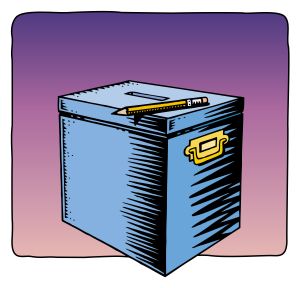
SO maybe elections aren’t quite around the corner as some assumed, but even so, are citizens sufficiently educated on how to vote?
It is widely assumed that marking “X” next to a candidate’s name is the only legitimate way to vote. It is not. So long as a mark, not necessarily an “X”, indicates the voter’s choice, it can be deemed legitimate by the presiding officer. An Election Commission (EC) guidebook, Panduan Memutuskan Undi Ragu, helps the presiding officer decide if a doubtful ballot is spoilt or is counted as a valid vote.
European parliamentary elections adopt a similar practice of accepting marks other than “X”. In Malaysia, however, doubts over the integrity of the electoral system have birthed Bersih 2.0 and other similar movements. Civil society groups now train volunteers to be election monitors, booth (barong) agents, and polling and counting agents, something formerly done mainly by political parties. They also cover training on doubtful votes, due to concerns that dubiously marked ballots could end up influencing an election outcome. Can this really happen?
Contradictions
Tindak Malaysia, a civil society group that trains polling and counting agents, says there are contradictions in the Conduct of Elections (COE) Regulations 1981. This is the law that governs voting and ballot-counting procedures.
By law, basic instructions on how to vote are listed in the Second Schedule, which must be posted outside the door of every polling stream. It states, among other instructions, that every person can vote only once and for one candidate only. As a voter, you also have the right to ask for a new ballot paper if the first one given to you is spoilt or has marks on it.
Importantly, the Second Schedule tells voters that they are to “mark a cross in the space provided on the right-hand side of the ballot paper, opposite the candidate’s name for whom they vote; that is, with ‘X’”. COE Regulation 25 (7)(d) then allows presiding officers to reject ballot papers that are “marked or unmarked other than in the place or manner provided”.
However, Regulation 25 (8) states: “Notwithstanding paragraph (7)(d), where the presiding officer is satisfied that any mark made on a ballot paper clearly indicates the intention of the voter and the candidate for whom he has given his vote, the presiding officer shall not reject the ballot paper…”
And under Regulation 25 (10), the presiding officer has the final say on whether any ballot paper should be rejected.
The rules appear to contradict each other, although it could be argued that this is acceptable to make allowances for those unfamiliar with the voting process. Let’s, however, look at what the guidebook says about accepting doubtful votes.
Doubtful votes
Compare these images from the guidebook:
![]() A doubtful ballot that can be accepted:
A doubtful ballot that can be accepted:
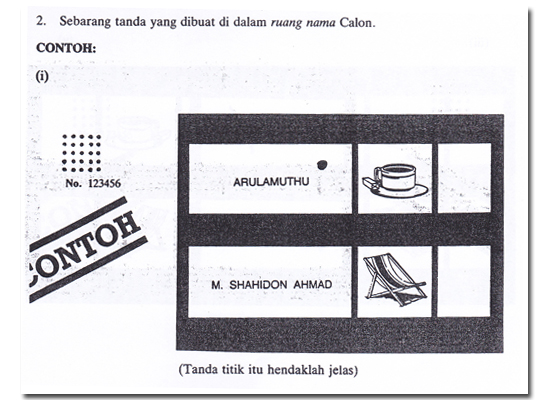
![]() Also acceptable:
Also acceptable:
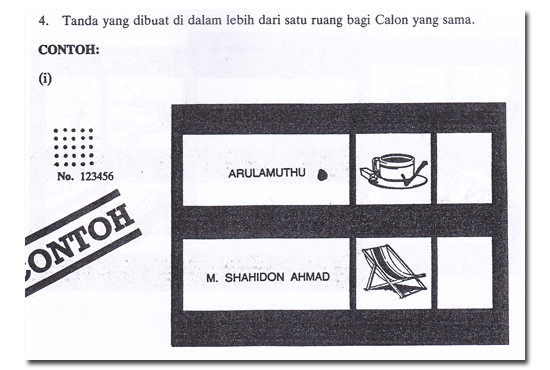
![]() A doubtful ballot that the guidebook rejects:
A doubtful ballot that the guidebook rejects:
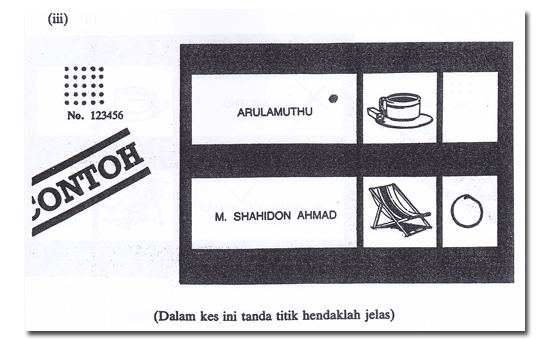
Tindak Malaysia founder PY Wong told The Nut Graph that he believes such guidelines allow for the possibility of cheating, such as by tainting the ballot paper with a dot (image 1) before it is issued to the voter. The ballot is accepted as a valid vote if the voter chooses the same candidate (image 2). But if the voter chooses the other candidate, the vote becomes a spoilt ballot (image 3).
![]() Another example of an acceptable ballot:
Another example of an acceptable ballot:
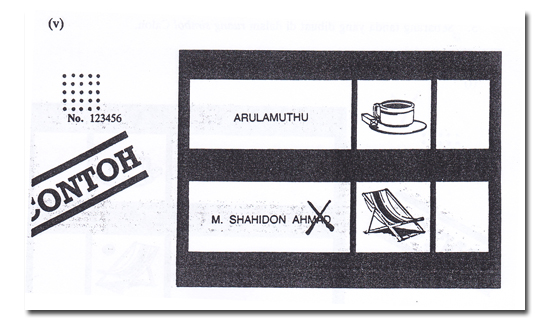
![]() A ballot that the guidebook rejects:
A ballot that the guidebook rejects:
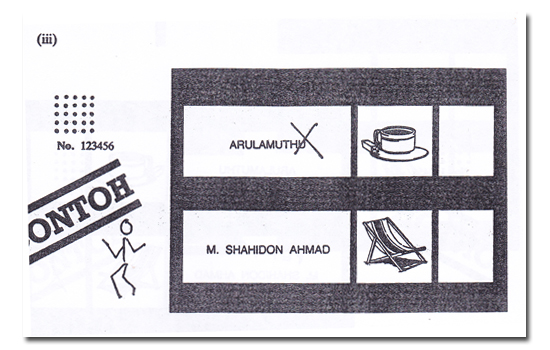
So, on the one hand, a ballot is valid as long as the voter’s intended choice of candidate can be established, even if the mark isn’t in the proper place. On the other hand, a vote can be rejected if there are other markings on other parts of the ballot paper, even if the “X” is in the correct place.
There are 31 different combinations of markings that can be accepted as valid votes in the guidebook. “It is odd that a process that has only one possibility has been broadened to cover 31 different combinations,” Wong said in an email interview.
Unnecessary, unhealthy suspicion
It is difficult to prove that doubtful votes can be used to the advantage of a particular candidate. Where spoilt votes outnumbered the winning majority in the 2008 general election, the seats concerned were won by both Barisan Nasional (BN) and Pakatan Rakyat candidates. Elections analyst Dr Ong Kian Ming counted 12 such parliamentary seats in the 2008 election. Four seats with the highest number of spoilt votes were Alor Star, won by the MCA, Lumut (MCA), Hulu Selangor (Parti Keadilan Rakyat) and Bakri (DAP).
“It is hard to argue that the EC rejects votes for the opposition which may be spoilt, or accepts votes for the BN which may be spoilt,” Ong said in an email. “There are also voters who purposely spoil their vote as a protest because they don’t want either of the candidates.”
Nevertheless, contradictions in the law and the generous leeway in deciding on doubtful votes give rise to “unnecessary and unhealthy suspicion about the intentions of the EC”, Tindak Malaysia said in its response to the Parliamentary Select Committee (PSC)’s report on electoral reform.
“The issue is public confidence, not whether it favours any particular candidate,” Wong said. “The process should be made simple and transparent.”
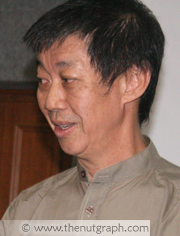
Wong said Tindak Malaysia and Bersih 2.0 presented a joint recommendation to the EC that only the Second Schedule be used in deciding doubtful votes. Since the schedule so clearly states that marking a ballot paper should only be done with an “X”, why confuse the process with other caveats? The EC, however, has not taken up this proposal, and the PSC report did not address it.
Voter vigilance
It falls on polling and counting agents to be vigilant on polling day. NGOs like Tindak Malaysia and political parties have trained thousands of volunteers on tasks such as checking the ballot paper books before voting starts, and assisting voters in exercising their rights during the balloting process. Counting agents are told to stay for the entire duration of the counting process to witness and object to dubious decisions by the presiding officer on doubtful votes.
Such safeguards were nearly lost. The legal provisions mandating polling and counting agents were removed under proposed amendments to the Elections Offences Act, which were later withdrawn after protests from opposition representatives. The entire bill, with other amendments, was later withdrawn, reportedly due to the resistance against it.
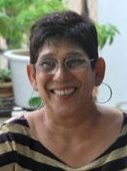
Although the law still allows polling and counting agents, nothing is guaranteed. DAP worker Mary Josephine Pritam Singh, a counting agent in the April 2011 Sarawak elections, said the presiding officer at her polling station did not give agents any chance to object to doubtful votes.
“The officer just consulted the guidebook and announced ‘this ballot is accepted, this one is not’ and so on, and ignored my objections. That is against the law, which allows counting agents, together with the presiding officer, to consult with one another on doubtful ballots. Only if there is no agreement, then the guidebook is consulted,” she said in a phone interview.
The DAP veteran, who has been a polling and counting agent in every general election since 1974 and in every by-election that the DAP has been involved in, also trains the party’s polling and counting agents. She said agents on duty must inform or remind the presiding officer of the counting agent’s role in helping to decide on doubtful votes, as provided for in another EC guidebook for polling, counting and booth agents.
However, as being a polling or counting agent is purely voluntary, there may not be enough volunteers to cover all polling stations in all 222 parliamentary constituencies. It falls on voters to be alert on polling day, and to know their rights under the law that allows them to ask for a new ballot paper if there are suspicious markings on the first one issued to them. ![]()
Disclosure: Deborah Loh has undergone polling and counting agent training by Tindak Malaysia.

